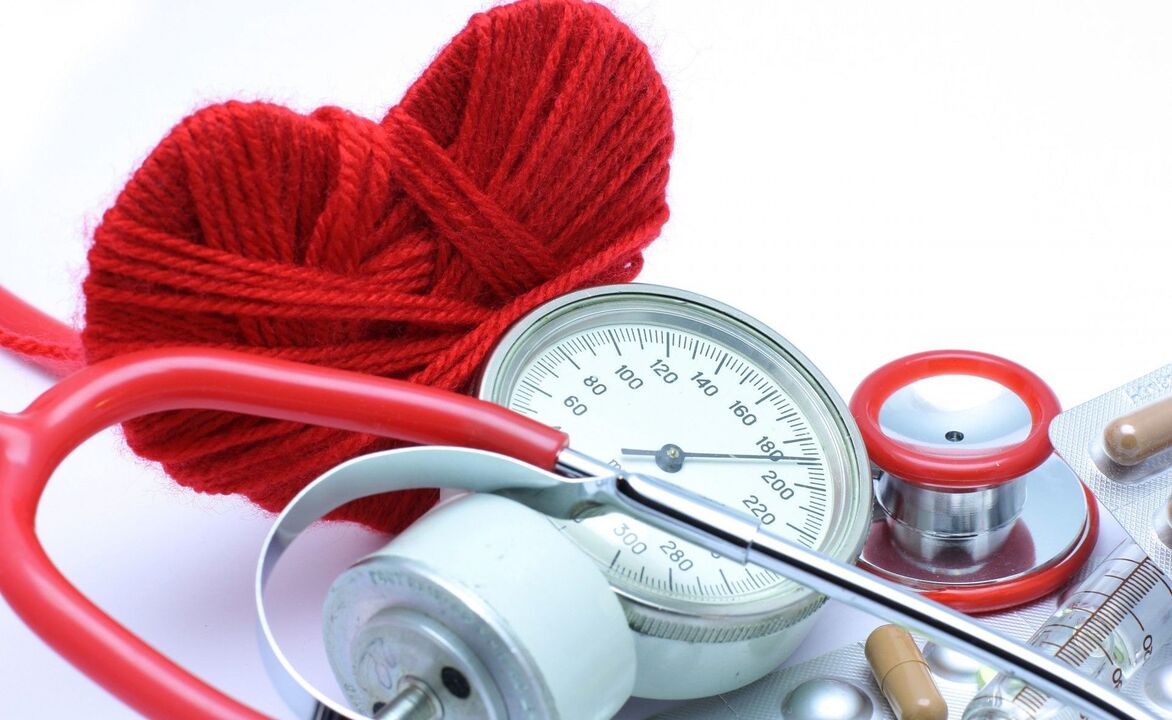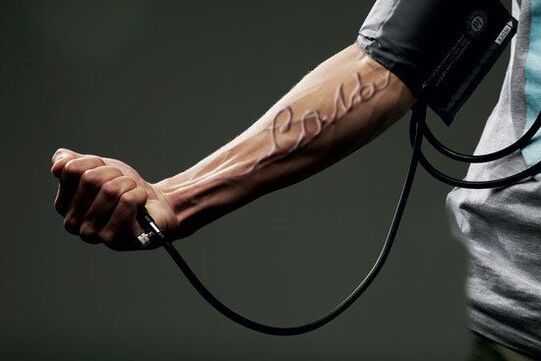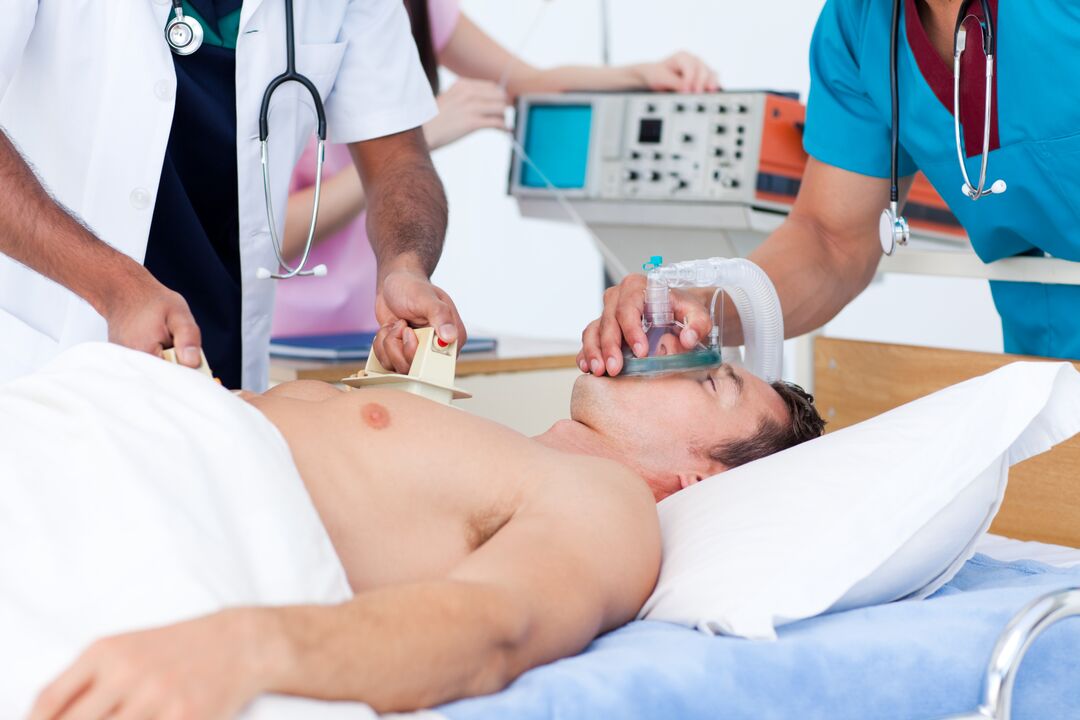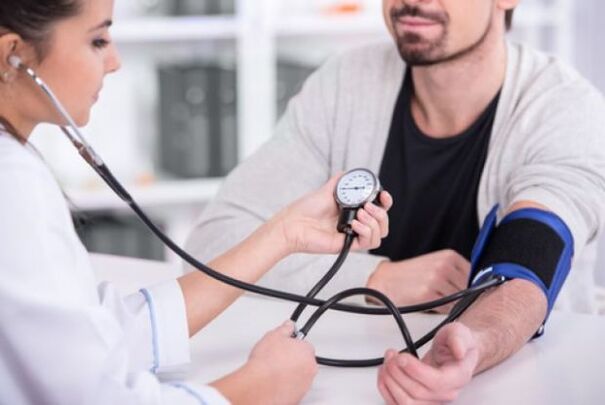According to the World Health Organization, hypertension is one of the most common diseases. Hypertension occurs in every third person, and is characterized by a high mortality rate in severe stages. Only a complex treatment that combines medication and maintaining a healthy lifestyle can be successful.

What is hypertension
What is hypertension is a chronic disease, a pathology of the cardiovascular system. It develops as a result of disorders in the work of higher centers responsible for the functionality of blood vessels. Dangerous complications of hypertension and accompanied by internal diseases.
One of the main manifestations of the disease is high blood pressure (blood pressure), which decreases only after taking special and strong medications.
Hypertension refers to a pressure of 140/90 mm Hg. and more if confirmed during two medical examinations.
Hypertension is divided into several types:
- Essential arterial hypertension,
- Symptomatic arterial hypertension,
- chronic hypertension,
- Vascular hypertension.
Symptomatic or secondary hypertension accounts for only 10% of all reported cases. Hypertensive syndrome - another name for the disease - most often accompanies systemic lupus erythematosus, urolithiasis, anomalies and tumors of the kidneys, ischemia, toxicosis in late pregnancy, renal tuberculosis. Despite the fact that hypertension does not have its own signs and characteristics, it seriously exacerbates the underlying disease.
Essential hypertension is an independent form of the disease.
Chronic hypertension is usually caused by excess calcium in the blood, infectious diseases (converted to chronic), diabetes mellitus and heredity. It manifests itself in the form of nervousness, distraction, fatigue and weakness, frequent numbness of the arms and legs, speech disorders, left ventricular hypertrophy and frequent pain in the heart area.
How does hypertension develop?
The mechanism of development of hypertension is as follows: in response to the stress factor, the regulation of tone in the peripheral vessels is violated. The result is spasm of the arterioles, and the development of dyscirculatory and dyskinetic syndrome. The secretion of neurohormones in the aldosterone system is significantly increased. This causes a delay in the vascular bed of sodium and water, which increases the volume of blood circulation and increases the pressure. During the disease, the viscosity of the blood also increases, which leads to a decrease in the speed of the metabolic process in the tissues. The walls of the vessels increase in size, the gap between them narrows, which affects blood flow. High levels of resistance in the periphery make the disease irreversible. As a result of increased permeability and impregnation of blood vessel walls with blood plasma, arteriosclerosis and elastofibrosis develop, which leads to serious changes in the tissues of certain organs.
Hypertension cannot occur spontaneously in humans. Hypertension is usually preceded by vegetative-vascular dystonia (VD), which is often accompanied by varicose veins.
Varicose veins and hypertension are related: increased activity of the walls of blood vessels in SVD leads to a decrease in their diameter. The resistance of the vessel wall to blood flow increases, which increases blood pressure. Varicose veins are characterized by thickening of the vessel wall, the formation of pockets and narrowing inside, which interferes with normal blood flow. Diseased veins can no longer cope with blood flow, which leads to the formation of edema in the tissues and chronic stagnation in the veins. This can turn into the development of gangrene, sepsis and even death.
Classification of diseases
Hypertensive disease differs in the causes of the increase in pressure, organ damage, blood pressure level and flow. The disease can be benign, or slowly progressive, or rapidly progressive - malignant. Classification according to the level and stability of pressure is more important. differentiate:
- normal GB (up to 129/85 mm Hg),
- limit (up to 140/90 mm Hg),
- grade I hypertension (up to 160/100 mm Hg),
- 2 degrees (up to 180/110 mm Hg),
- 3 degrees (over 180/110 mm Hg).
Benign hypertension has three stages. The first or mild is characterized by an increase in pressure up to 180 to 104 mm Hg, but after a short rest it returns to normal. Some people complain of headaches, sleep problems, fatigue and reduced performance. However, in most cases, the mild stage proceeds without pronounced individual symptoms.
The second or middle stage is characterized by a pressure of up to 200 to 115 mm Hg. in peace. It is followed by strong and pulsating headaches, dizziness, pain in the heart area. Examination reveals heart damage. Sometimes subendocardial ischemia is detected. Strokes are possible, transient cerebral ischemia.
The third or difficult stage is accompanied by a stable and strong increase in pressure. At the beginning of the stage, high blood pressure is occasional, and it is most often manifested after physical effort, as well as changes in atmospheric pressure and emotional upheavals. Normalization is possible after myocardial infarction or stroke. Headless hypertension often occurs after a heart attack. That is, a condition in which only systolic or pulse pressure decreases.
Reasons for the development of diseases
The causes of hypertension lie in the violation of the regulatory activity of the main parts of the central nervous system, which control the work of all internal organs. Frequent overexertion and overload, both physical and mental, prolonged, constant and strong unrest, stress can lead to development.
Working at night, often staying in a noisy environment can also cause illness.
The risk group includes lovers of salty foods. Salt causes cramps in the arteries and prevents the removal of fluid. Heritage plays an important role. The likelihood of developing the disease increases if hypertension is present in two or more relatives.
Some diseases also cause the development of hypertension. This includes:
- Diseases of the adrenal glands and kidneys,
- thyroid disease,
- obesity,
- diabetes diabetes,
- tonsillitis
- Atherosclerosis.
Among women in the most at-risk group, those who are menopausal. This is due to hormonal changes in the body, emotional deterioration, nervous reactions. In menopause, about 60% of all diseases occur in women.

In men, age and gender determine increased risk. Hypertension between the ages of 20 and 30 develops in about 9% of men. At the age of 40, the percentage increases to 35, and after 65 - already 50%. Hypertension is more common in men under the age of 40 than in women. In the older age group, the ratio changes - this is explained by the high mortality rate of men from complications.
The causes of hypertension lie in hypodynamics and bad habits. The components of tobacco smoke cause spasms of blood vessels and damage the thin walls of arteries. Physical inactivity is accompanied by a slow metabolism, and in the case of increasing the load, the untrained heart gets tired many times faster.
Symptoms
The clinical stage of hypertension may be mild. For a long time, a person may not even be aware of the increased pressure and processes that develop in the blood vessels. Early and first signs of hypertension are irritability for no reason and increased fatigue.
Symptoms of hypertension in the early stages: neurotic disorders, weakness, sleep disorders, noise and tinnitus and dizziness, palpitations.
People notice a decrease in efficiency, a loss of concentration. There is shortness of breath. Headache with hypertension is more common in the morning in the temporal and occipital region. By the end of the day, it can also increase in the supine position. They are associated with violations of the tone of the venules and arterioles. Symptoms of hypertension include pain in the heart. This is due to the increased work of the heart muscle to overcome the increasing resistance. As a result, there is a dissociation between the needs and possibilities of the myocardium, which leads to angina pectoris.

Signs of hypertension later include a veil and flickering "flies" in front of the eyes, as well as other photopsies. They are explained by spasms of the retinal arterioles. Malignant hypertension may be accompanied by retinal hemorrhage, leading to blindness. In rare cases, the symptoms of hypertension are manifested by vomiting, swelling of the hands and numbness of the fingers, chills, in the morning - heaviness in the eyelids and puffiness of the face, excessive sweating.
Complications during hypertension
Complications of hypertension:
- Hypertensive crisis,
- visual impairment,
- Circulatory disorders in the brain
- nephrosclerosis,
- subarachnoid hemorrhage,
- Dissecting aortic aneurysm,
- bradycardia,
- Damage to target organs (kidneys, heart, brain, veins and arteries, fundus vessels),
- Hypertensive cardiomyopathy (HLH, left ventricular hypertension)
- Hypertensive angiodystonia.
Hypertensive crisis
You must first understand what a hypertensive crisis is. This term refers to an acute and significant increase in blood pressure, which is accompanied by symptoms characteristic of the disease. In addition to hypertension, it can be caused by:
- Chronic and acute glomerulonephritis,
- Toxicity in late pregnancy,
- renovascular hypertension,
- benign brain tumors,
- heavy metal poisoning,
- Kidney failure.
Crises can be caused by hormonal imbalances and sudden changes in weather. One of the most common causes is trauma of a psycho-emotional nature. Symptoms: severe and severe headache, nausea with nausea, dizziness, fainting, short-term blindness and other visual disturbances, weakness, mood swings, crying. Brain symptoms:
- vasospasm,
- Violation of vascular wall permeability,
- Entry of blood plasma into the medulla, leading to edema.
In the initial stages of the disease, crises are mild and short-lived.

Danger of crisis in possible development:
- retinal detachment,
- stroke,
- Acute pulmonary edema
- cardiac asthma,
- myocardial infarction,
- Angina.
Complications of hypertension pose a serious threat to human life and require regular monitoring by a physician.
Brady
A common and dangerous complication of hypertension. It manifests itself depending on the form. The mild form may go unnoticed. Severe, frequent and prolonged dizziness with hypertension may indicate a pronounced form of the disease. Also, symptoms include - semi-fainting and frequent fainting, sudden changes in pressure. The severe form is accompanied by fainting and short-term cardiac arrest. Treatment of bradycardia with hypertension can be done with homeopathic and medical remedies. Diuretics, alpha-blockers, nifedicipin are usually prescribed. Marigold, St. John's wort, strawberries, and shakers are prescribed for homeopathy.
Complications include the following syndromes in hypertension:
- myocardial injury,
- kidney damage,
- vascular encephalopathy,
- Arterial hypertension syndrome.
Related clinical conditions: ischemic stroke, CHF, coronary revascularization, renal failure, arterial disease, papillary edema.
Damage to the target organ
Heart
Left ventricular hypertrophy most commonly develops. This happens because the heart muscle has to push the blood into the deformed vessels with great effort. Such work leads to thickening of the muscle wall and lack of blood circulation. This is dangerous due to muscle tension and heart fatigue. Another pathology is a violation of the diastolic function of the liver. Increasing fatigue of the heart muscle leads to the moment when it cannot take a relaxed position. The thickened wall cannot relax during the diastolic phase, in which oxygen saturation normally occurs. All this leads to the third pathology - chronic insufficiency. They develop as a result of constant oxygen starvation. The disease is very difficult to treat, and in combination with other pathologies leads to death.
Vessels
The arterial vessels in hypertension are in a constant narrowed state due to the contraction of the muscle layer. This leads to the fact that the veins stop relaxing and the muscle tissue is replaced by connective tissue. This is called vascular remodeling. Vision loss, peripheral limb atherosclerosis and other diseases are associated with this complex and irreversible consequence.
The brain
Bleeding causes almost 25% of all strokes. And hypertension is the main cause of bleeding, which have a high percentage of deaths. Insufficient blood supply to the brain leads to ischemic stroke. This complication occurs in more than 70% of cases. It is caused by narrowing of the cerebral arteries or blockage of the ducts by a thrombus. Another pathology is hypertensive encephalopathy. This is an emergency, accompanied by severe headache, high blood pressure, neurological symptoms. If you have hypertension, there is a possibility of developing cognitive impairment and dementia. These are changes in the subcortical substance and atrophy of the brain, which are responsible for the violation of thought processes.
kidneys
One of the most common complications is microalbuminuria. The earliest sign of kidney damage and the development of kidney failure. Chronic renal failure is characterized by loss of the ability of the kidneys to remove metabolic products from the blood.
Diagnosis of the disease
Effective treatment of hypertension is possible only with early diagnosis and compliance with all rules and recommendations. High blood pressure is not always an indicator of hypertension, it can be situational. Even with repeated visits to the doctor, it is not detected. One measurement of blood pressure may not detect the disease: in case of recurrent symptoms, it is necessary to measure blood pressure in dynamics. After the diagnosis is made, doctors make a differential diagnosis to determine the symptomatic form of the disease.

Pressure measurement
Dynamic pressure measurement is used to determine the degree and presence of the disease. It is performed as follows: the atmosphere should be pleasant and calm. Measurements begin no later than ten minutes after the start of patient admission. An hour before the visit, smoking, taking any food and strong drinks (tea, coffee, alcohol), any physical activity, use of eye or nose drops are excluded. During the first treatment, the blood pressure measurement is measured with both hands of the patient, and the second measurement after 2 minutes.
With a reading difference greater than 5 mm Hg. continue measuring on the hands with high pressure.
Treatment of hypertension
How to treat hypertension depends on the stage of the disease, complications, age and many other parameters. Treatment options are chosen by the attending physician. The desire to fight the disease on your own can turn into catastrophic consequences. Modern treatment of hypertension begins with non-drug methods that increase the effectiveness of drugs many times over. For starters you need to establish a daily routine, eliminate any stress, do not forget about exercise and long walks. An important point in how to deal with hypertension is diet. The patient should refuse or significantly reduce salt intake, drink less, completely eliminate alcoholic beverages and coffee. If you follow all the recommendations, you can avoid treating the disease with medication.
In treatment, it is important not only how to deal with hypertension, but also how to eliminate the causes of high blood pressure.
Medications are usually used for treatment:
- diuretic,
- Inhibitors
- Type 2 receptor antagonists
- Calcium channel blockers.
Prescription blood pressure medications - prescription only
homeopathic treatment
With regard to the question of how to get rid of hypertension, it is worth paying attention to homeopathic remedies. They are usually recommended when the target organs are already affected. Homeopathy for hypertension has an important advantage: mild action. The drugs have no contraindications or side effects. The downside is that treatment with homeopathic remedies is quite slow. When choosing this method, consider:
- Homeopathic medicines are prescribed at the same time as medicines,
- A combination of medication and a healthy lifestyle
- With an average level of risk, this species is often the only one possible.
Inpatient treatment of hypertension
Inpatient treatment is usually received with a complicated hypertensive crisis:
- Acute hypertensive encephalopathy,
- cardiac asthma,
- pulmonary edema,
- acute coronary syndrome (unstable angina pectoris and myocardial infarction),
- aortic aneurysm,
- Severe arterial bleeding
- Eclampsia.
Upon admission, the clinic's doctors begin to perform the main diagnostic actions:
- Measurement of blood pressure dynamics every 15 minutes,
- electrocardiography,
- General analysis of blood and urine,
- echocardiography,
- Biochemical analysis for the detection of potassium, sodium, urea, calcium, creatinine, fibrinogen, coagulogram,
- Ophthalmoscopy.
Also, the patient must be prescribed an examination by a neurologist, Reberg test and rheoencephalography, as well as determining the type of cerebral hemodynamics. Inpatient treatment in the hospital depends on the presence of complications, severity of attacks and other diseases. First aid is aimed at reducing the activity of the left ventricle and eliminating symptoms such as:
- peripheral vasoconstriction,
- cerebral ischemia,
- Heart Failure.
Of great importance in the treatment of complicated seizures is the introduction of antihypertensive drugs, hospitalization in the intensive care unit and regular monitoring of blood pressure.
Non-drug treatment of hypertension includes strengthening the immune system, cleansing the body, massage, gymnastics and diet. It is important to follow the doctor's instructions, and not to violate the established regime.
How to live with hypertension
How long people live with hypertension is an important question for those diagnosed with it. The consequences of the disease depend on the stage and nature of its course. Severe form, vascular damage, third stage of the disease and disorder of the target organs worsen the prognosis. Premature death results from heart attacks and strokes, acute heart failure. Unfavorable prognosis for those who became ill at an early age.
The life expectancy of a hypertensive person depends not only on the correctness of taking medication and regular visits to the doctor, but also on personal attitude and respect for basic rules. This includes:
- psychological climate,
- diet,
- physical exercises,
- No bad habits.
Another important condition is to understand what kind of disease it is, how it develops and what consequences it has on the whole organism. It is not necessary to have a medical education to understand the characteristics of the course of the disease. There are many good books and manuals written for ordinary people. One of them is "Propaedeutics of Internal Medicine" by A. Yakovlev, which briefly and clearly states the main provisions on hypertension, as well as the most popular treatment regimens for hypertension.
Psychological climate
Having figured out how to treat hypertension and choosing a method of treatment, you need to move on to an equally important issue - a healthy lifestyle. This is impossible when working in the night shift, frequent quarrels, constant and long business trips, strong emotional stress, negative emotions, fears, anger. All these conditions are accompanied by the production of adrenaline in large quantities, which leads to disorders of the bloodstream and nervous system. It is important to control your emotions, think more positively and exclude all sources of stress from your environment. Herbal teas, meditations, walks, doing what you love will help you with that.
By creating the most comfortable conditions around you, a person increases the chances of his recovery.
Diet
Overweight and hypertension are incompatible. Even if there is no excess weight, treatment begins with dietary correction. In the initial stages, this is enough to control the pressure and prevent it from increasing. There are several ways to lose weight with hypertension. The main one is calorie restriction. This can be achieved by eliminating or reducing the daily diet of sweet and fatty foods, flour products. Diet for weight loss should not be confused with fasting: it is forbidden to hypertensives. To lose weight and normalize blood pressure, you should also monitor the amount of animal fats in your diet. It is necessary to exclude foods rich in cholesterol as much as possible, as well as to switch to low-fat varieties of fish, fruits and vegetables, and natural vegetable oils. It is worth to completely abandon sausages, lard, fried meatballs and fatty meats, butter, fatty cheeses.
Contraindications for hypertension - any drink and food that excites the nervous system. This includes not only tea, coffee and alcohol, but also carbonated drinks, hot spices, fragrant spices.
It is important to include foods rich in potassium and magnesium in your diet. These elements have a good effect on the heart muscle, strengthen the walls of blood vessels and the nervous system. A lot of potassium is found in:
- prunes,
- apricots,
- cabbage,
- pumpkin,
- Bananas.
Rich in magnesium:
- Buckwheat, oats and millet semolina,
- carrot,
- beet,
- black currant,
- Parsley and lettuce leaves
- walnuts.
Important rule: these products should not be combined with milk. Calcium negatively affects the digestibility of the elements.

Physical exercises
Complications of arterial hypertension and the disease itself do not mean that the patient should give up any activity. Gymnastics, simple exercises, yoga or long walks, swimming are indicated for hypertensives. The movement not only carries a charge of positive emotions, but also helps in the fight against excess weight.
You should start with the simplest exercises, gradually increasing the time and complexity of the exercises. This also applies to swimming and walking.
Rehabilitation in third-degree hypertension, as well as in complications such as hypertensive stroke, coronary heart disease, angina pectoris, should be performed only under the supervision of a physician. Usually, rehabilitation patients are sent to special resorts for sanatorium treatment. Which includes a whole range of measures: proper nutrition, physical activity, medication.





















